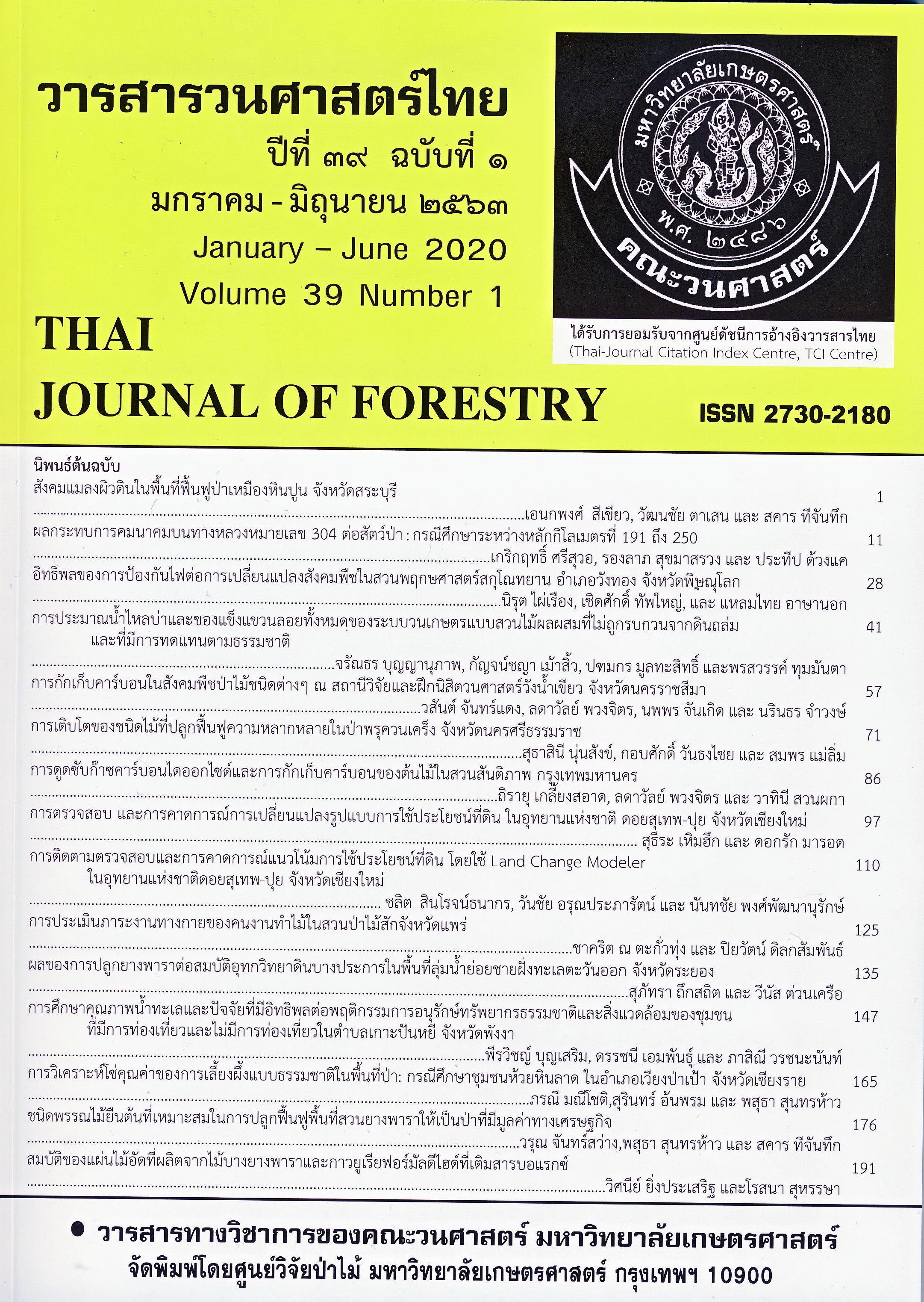อิทธิพลของการป้องกันไฟต่อการเปลี่ยนแปลงสังคมพืชในสวนพฤกษศาสตร์สกุโณทยาน อำเภอวังทอง จังหวัดพิษณุโลก
Main Article Content
บทคัดย่อ
การศึกษาอิทธิพลของการป้องกันไฟต่อการเปลี่ยนแปลงสังคมพืชในสวนพฤกษศาสตร์สกุโณทยาน อำเภอวังทอง จังหวัดพิษณุโลก มีวัตถุประสงค์เพื่อระบุชนิดของไม้ต้น และศึกษาโครงสร้างของสังคมพืชที่เปลี่ยนแปลงไป เนื่องจากอิทธิพลของการกันไฟต่อเนื่องเป็นเวลานาน ด้วยการวางแปลงตัวอย่างแบบเป็นระบบ ขนาด 20x20 เมตร กระจายทั่วพื้นที่ จำนวน 26 แปลง ทำการเก็บข้อมูลชนิด จำนวนต้น และขนาดเส้นรอบวงเพียงอกของไม้ต้น ระหว่างเดือนมีนาคมถึงเดือนมิถุนายน 2560 พร้อมทั้งเก็บตัวอย่างดินในแต่ละแปลง เพื่อตรวจวิเคราะห์สมบัติในห้องปฏิบัติการ ผลการศึกษาพบว่า มีชนิดไม้ต้น 79 ชนิด 66 สกุล 34 วงศ์ โดยประดู่ป่า (Pterocarpus macrocarpus) สาธร (Millettia leucantha) และยางเหียง (Dipterocarpus obtusifolius) เป็นชนิดไม้ที่มีดัชนีค่าความสำคัญ (IVI) สูงสุด 3 อันดับแรก เท่ากับร้อยละ 25.4, 21.7 และ 16.4 ตามลำดับ สามารถจัดกลุ่มหมู่ไม้ (CA) ออกเป็น 3 สังคมพืช ได้แก่ สังคมป่าเต็งรัง (DDF) สังคมป่าผสมผลัดใบ (MDF) และบริเวณรอยต่อของป่า (ECA) หรือสังคมป่ารุ่นสอง สำหรับความสามารถในการสืบต่อพันธุ์ของชนิดไม้เด่นแต่ละหมู่ไม้ พบว่า ในสังคมป่าเต็งรังและบริเวณรอยต่อของป่า ไม่ประสบความสำเร็จ เนื่องจากไม่พบกล้าไม้และไม้รุ่นของชนิดพันธุ์ดังกล่าวในพื้นที่ ต่างจากชนิดพันธุ์เด่นในสังคมป่าผสมผลัดใบ ที่มีการสืบต่อพันธุ์ได้ดี เพราะว่าพบทั้งกล้าไม้และไม้รุ่นเจริญอยู่เป็นจำนวนมาก ผลที่เกิดขึ้นจากการกันไฟป่าต่อเนื่องเป็นเวลานาน ทำให้ดินในป่าบริเวณรอยต่อของสังคมพืช มีความชื้นต่างจากป่าเต็งรังอย่างมีนัยสำคัญ ส่งผลให้เมล็ดไม้ของพืชในป่าผสมผลัดใบที่อยู่ใกล้เคียง สามารถรุกล้ำเข้ามาเจริญเป็นกล้าไม้และตั้งตัวเป็นไม้รุ่นได้มากขึ้น ก่อให้เกิดการเปลี่ยนแปลงชนิดพันธุ์เด่นและโครงสร้างของสังคมพืชจากป่าเต็งรังและบริเวณรอยต่อของสังคมไปเป็นป่าผสมผลัดใบ เนื่องจากไม่มีไฟป่าเป็นตัวกำจัดกล้าไม้และไม้รุ่นของชนิดไม้จากป่าเบญจพรรณที่รุกล้ำเข้ามาให้หมดไป
การป้องกันไฟป่าต่อเนื่องเป็นเวลายาวนาน ส่งผลให้พื้นที่ป่าเต็งรังมีพื้นที่ลดลง เนื่องจากชนิดไม้เด่นในสังคม ไม่ประสบความสำเร็จในการสืบต่อพันธุ์ตามธรรมชาติ ดังนั้น แนวทางในการอนุรักษ์และจัดการป่าไม้ในพื้นที่สวนพฤกษศาสตร์สกุโณทยาน จึงควรมีการเผาป่าแบบมีการควบคุม เพื่อให้โครงสร้างป่าและชนิดไม้เด่นในสังคมของป่าเต็งรังสามารถสืบต่อพันธุ์ตามธรรมชาติได้ตามปกติ
Downloads
Article Details
ข้าพเจ้าและผู้เขียนร่วม (ถ้ามี) ขอรับรองว่า ต้นฉบับที่เสนอมานี้ยังไม่เคยได้รับการตีพิมพ์และไม่ได้อยู่ในระหว่างกระบวนการพิจารณาตีพิมพ์ลงในวารสารหรือสิ่งตีพิมพ์อื่นใด ข้าพเจ้าและผู้เขียนร่วม (ถ้ามี) ยอมรับหลักเกณฑ์และเงื่อนไขการพิจารณาต้นฉบับ ทั้งยินยอมให้กองบรรณาธิการมีสิทธิ์พิจารณาและตรวจแก้ต้นฉบับได้ตามที่เห็นสมควร พร้อมนี้ขอมอบลิขสิทธิ์ผลงานที่ได้รับการตีพิมพ์ให้แก่วารสารวนศาสตร์ คณะวนศาสตร์ มหาวิทยาลัยเกษตรศาสตร์ กรณีมีการฟ้องร้องเรื่องการละเมิดลิขสิทธิ์เกี่ยวกับภาพ กราฟ ข้อความส่วนใดส่วนหนึ่ง หรือ ข้อคิดเห็นที่ปรากฏในผลงาน ให้เป็นความรับผิดชอบของข้าพเจ้าและผู้เขียนร่วม (ถ้ามี) แต่เพียงฝ่ายเดียว และหากข้าพเจ้าและผู้เขียนร่วม (ถ้ามี) ประสงค์ถอนบทความในระหว่างกระบวนการพิจารณาของทางวารสาร ข้าพเจ้าและผู้เขียนร่วม (ถ้ามี) ยินดีรับผิดชอบค่าใช้จ่ายทั้งหมดที่เกิดขึ้นในกระบวนการพิจารณาบทความนั้น”
เอกสารอ้างอิง
Bunyavejchewin, S. 2012. Structure and Dynamics of Deciduous Dipterocarp Forest. Department of National Parks, Wildlife and Plant Conservation, Bangkok. (in Thai)
Bunyavejchewin, Y. Jamlongrat, R. Buasalee and P. Rayanggul. 2016. Trees & forest of Huai Kha Kaeng Wildlife Sanctuary. Amarin Printing & Publishing, Bangkok. (in Thai)
Forest Fire Control Division. 2016. Strategies for Solving Forest Fire and Smog Problems Annual Report 2016. Forest Protection and Fire Control Office, Department of National Parks, Wildlife and Plant Conservation, Bangkok. (in Thai)
Gardner, S., P. Sidisunthorn and V. Anusarnsunthorn. 2000. A Field Guide to Forest Trees of Northern Thailand. Kobfai Publishing Project, Bangkok. (in Thai)
Kiriratnikom, A., S. Kiriratnikom and T. Sumpunthamit. 2016. Litter decomposition and nutrient release in Ban Nong-Tin Community Forest, Phapayom district, Phatthalung province. Thaksin Journal 19(2): 33–41. (in Thai)
Kutintara, U. 1999. Ecology Fundamental Basics in Forestry. Department of Forest Biology, Faculty of Forestry, Kasetsart University, Bangkok. (in Thai)
Land Development Department. 2010. Operating Manual for Chemical Soil Analysis Process. Land Development Department, Ministry of Agriculture and Cooperatives, Bangkok. (in Thai)
Marod, D. 2011. Sampling Technique and Plant Community Analysis. Department of Forest Biology, Faculty of Forestry, Kasetsart University, Bangkok. (in Thai)
Marod, P. Duengkae, J. Thongsawi, W. Phumphuang, S. Thinkampheang, A. Kullawong and S. Hermhuk. 2017. Tree stands clustering and carbon stock assessmentof deciduous dipterocarp forest at Kasetsart University Chalermphrakiat Sakonnakhon Province Campus, Sakonnakhon province. Thai Forest Ecological Research Journal 1(1): 1–9. (in Thai)
McCune, B. and M.J. Mefford. 2011. PC-ORD. Multivariate Analysis of Ecological Data Version 6.08. MjM Software. Gleneden Beach, Oregon.
Niamrat, W. and D. Marod. 2005. Seedling establishment of climax species under the eucalyptus plantations and open areas. Thai Journal of Forestry 24: 35–47.
Paoin, T. and N. Paoin. 2011. Medicine Tree. Offset Place Co., Ltd., Bangkok. (in Thai)
Phitsanulok Provincial of Tourism and Sports. 2019. Sakunothayan Botanic Garden. Available Source: www.phtsanulokscanme.com/Sakunothayan Botanic Garden, September 8, 2019. (in Thai)
Santisuk, T. 2012. Forest of Thailand. The Forest Herbarium, Department of National Parks, Wildlife and Plant Conservation. Prachachon Co., Ltd., Bangkok. (in Thai)
Seub Nakhasathien Foundation. 2019. Forest Protection-Forest Fire. Available Source: https://www.seub.or.th/
bloging, September 8, 2019. (in Thai)
The Forest Herbarium. 2013. Tree Species Selection Guide for Afforestation and Flood Prevention: The North East. Department of National Parks, Wildlife and Plant Conservation, Bangkok. (in Thai)
Wanthongchai, K., J. Bauhus and J. G. Goldammer. 2014. Effects of past burning frequency on woody plant structure and composition in dry dipterocarp forest. Thai Journal of Forestry 33(3): 109–130.
Wattanasuksakul, S., S. Khamyong, N. Anongrak and K. Sri-ngernyuang. 2012. Impacts of forest fire on soil physico-chemical properties and nutrient storages in dry dipterocarp forest, In Takin Silvicultural Research Station, Chiang Mai province. Journal of Agriculture 28(1): 19–29. (in Thai)


